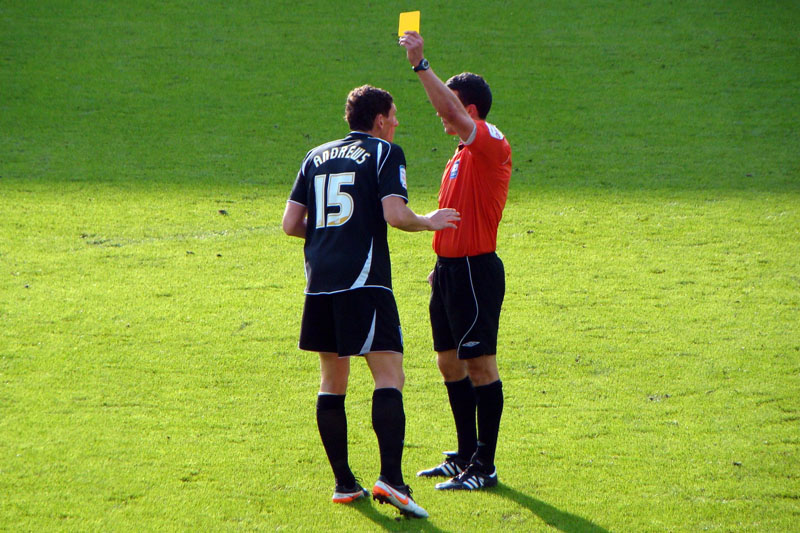In soccer, discipline, and fairness are vital to the game’s integrity. The disciplinary system includes various measures to manage player behavior. Yellow and red cards in soccer are the main tools for enforcing rules. FIFA introduced these cards at the 1970 World Cup. They aimed to standardize and clarify the referee’s decisions. This marked a big evolution in managing player conduct. The yellow card is a caution. The red card is for a serious breach of conduct. It leads to immediate consequences. Knowing the roles and rules of yellow and red cards in soccer helps us appreciate their role in keeping the game fair.
Understanding the Yellow Card in Soccer
In soccer, a yellow card is a formal warning. It is for unsporting or rule-breaking infractions. The referee issues this card to signal that a player has disrupted the game or violated the rules. The offense does not warrant an immediate expulsion. The yellow card acts as a cautionary measure. It means the player’s conduct has been noted. Further violations could lead to harsher penalties, including a red card.

Common Reasons for Issuance
- Unsporting Behavior: Actions such as diving, excessive protests, or taunting opponents.
- Persistent Fouling: Continuous committing of fouls that disrupt the game’s flow.
- Delay of Game: Wasting time, such as by taking too long to restart play.
Receiving a yellow card has implications for both the player and their team. A player who gets multiple yellow cards in a series of matches may face further punishment, like a suspension. For the team, a player on a yellow card must be cautious to avoid further infractions that could lead to a red card.
Understanding the Red Card in Soccer
A red card in soccer is a more severe disciplinary measure than a yellow card. The red card serves as a definitive sanction for serious infractions. It is issued to keep the game safe and fair. It means a player’s conduct is so harmful to the game that they must be removed from the field. Leaving their team with one less player for the remainder of the match.

Common Reasons for Issuance
- Serious Foul Play: Actions that endanger an opponent’s safety, such as a reckless tackle.
- Violent Conduct: Physical aggression or fighting, whether on or off the ball.
- Spitting or Abusive Language: Using offensive language or spitting at opponents or officials.
When a player receives a red card, they must leave the field immediately and cannot be replaced. This leaves the team with one less player on the field. It often leads to a big tactical disadvantage. The player may also face further disciplinary measures, such as a suspension for multiple matches.
Accumulation of Yellow Cards Leading to a Red Card
A player can also receive a red card as a result of accumulating multiple yellow cards.
- Two Yellow Cards in a Single Match: If a player gets two yellow cards in a game, they are shown a red card and sent off. This results in an immediate expulsion from the match.
- Accumulation Over Multiple Matches: Many leagues impose extra suspensions if a player gets a certain number of yellow cards across several matches.
Comparing Yellow and Red Cards
Yellow and red cards in soccer are key to enforcing rules. They serve different purposes and affect the game in different ways.
Differences in Severity and Consequences
- Yellow Card: A yellow card is a warning issued for less severe infractions. It signals that the player needs to modify their behavior to avoid further penalties. A yellow card does not immediately affect the team’s player count. But, multiple yellow cards over a season or tournament can lead to suspensions.
- Red Card: A red card signifies a serious violation of the rules. It removes the player from the game, leaving their team short one player. A player who gets a red card is usually banned for future matches. This can greatly affect their team’s performance and strategy.
Impact on Gameplay and Team Strategy
- With a Yellow Card: A player on a yellow card must be cautious. Further fouls could lead to a red card. The team may adjust its strategy to mitigate the risk of the player being sent off.
- With a Red Card: The team is now at a disadvantage. This may change their tactics. They may play more defensively to compensate for the loss of a player. The absence of the player can hurt their performance and chances of winning the match.
Historical Evolution
The system of issuing yellow and red cards in soccer has evolved. It aims to improve player behavior and ensure fair play. This evolution shows how these measures uphold the game’s integrity.
- Early Days: Before yellow and red cards, referees used only verbal warnings and direct expulsions to manage player conduct. This system lacked the visual clarity and standardization that cards provide.
- Introduction of Cards: FIFA introduced yellow and red cards in the 1970 World Cup. The system aimed to provide a clear, standard way for referees to penalize players and communicate their decisions.
- Evolution of Rules: Over the years, the criteria for issuing cards have been refined to address new issues in the game. The rules have been adjusted to improve match fairness and safety.
Conclusion
Yellow and red cards in soccer are key to its discipline system. Each serves a distinct role in keeping order and fairness on the field. The yellow card warns for minor infractions. The red card, for serious breaches, results in the player’s expulsion from the game. The evolution of these cards, from the 1970 World Cup to their use in modern tech like VAR, shows their role in upholding the game’s integrity. Knowing how and why these cards are used is important. It gives insight into the rules of soccer and the measures taken to ensure fairness. By adhering to these rules, players and teams help a sport that values both skill and sportsmanship.







